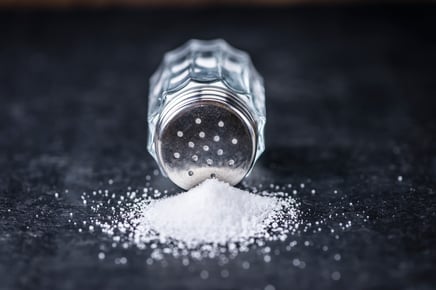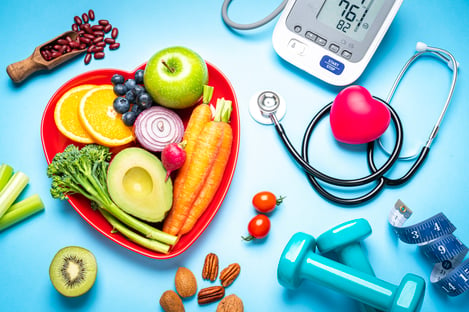 Sodium is a mineral and electrolyte that helps balance the amount of fluid and other minerals in your body. It also plays an important role in nerve and muscle function. The terms “sodium” and “salt” are typically used interchangeably; however, sodium is a mineral and one of the chemical components found in salt (also called sodium chloride). Sodium is found naturally in some foods, and added to others for flavor or preservation.
Sodium is a mineral and electrolyte that helps balance the amount of fluid and other minerals in your body. It also plays an important role in nerve and muscle function. The terms “sodium” and “salt” are typically used interchangeably; however, sodium is a mineral and one of the chemical components found in salt (also called sodium chloride). Sodium is found naturally in some foods, and added to others for flavor or preservation.
While some sodium is necessary for the body to function (~500 mg/day), over time consuming too much sodium can have undesirable health effects. One of the most notable consequences of consuming too much sodium is high blood pressure. High blood pressure can increase your risk of heart disease and stroke, the two leading causes of death in the U.S., as well as kidney disease, loss of vision, and many more health complications.
Where Is Sodium Found in Foods?
Although most people believe their sodium intake mainly comes from salt they add to food by hand, only around 10% of the average American’s sodium intake comes from salt added while cooking or eating. Instead, more than 70% of the sodium consumed by Americans is from packaged and processed foods and food from restaurants. According to the Dietary Guidelines for Americans, the largest contributors of sodium in the American diet include sandwiches (including burgers and tacos), pasta and other grain dishes, soups, pizzas, and meat and seafood dishes.
How Much Sodium Can I Consume?
The American Heart Association recommends consuming no more than 2,300mg (1 teaspoon) of sodium per day; however, consuming less than 1,500mg is preferred, especially in those with preexisting high blood pressure. Despite these guidelines, the average adult in the U.S. consumes close to 3,400mg of sodium each day.
How Can I Reduce My Sodium Intake?
To help reduce your sodium intake and promote overall health, try some of the following suggestions:
- Compare Nutrition Facts labels of various packaged foods and choose the one with the lowest sodium content.
- Select canned foods, such as vegetables and beans, with “no salt added” or “low sodium” listed on the label.
- Use herbs, spices, and other sodium-free seasonings to add flavor to food, rather than salt and salty seasoning blends.
- Limit foods that are pickled, cured, or smoked, as these tend to be high in sodium. Foods that are grilled, poached, or roasted may be better options.
- Choose whole, unprocessed foods such as fruits, vegetables, and whole grains. These foods tend to be very low in sodium.
- Minimize the amount of salt added during cooking and at the table.
- If you currently eat a lot of salt/sodium, try gradually reducing your intake to give your taste buds time to transition.
Sodium and Exercise
The recommendation to consume less than 1,500mg per day does not apply to everyone, particularly individuals who lose excess amounts of sweat, such as competitive athletes or outdoor construction workers. Sodium and potassium are the two major electrolytes lost in sweat, although the amount lost varies from person to person. Typically, it is appropriate to replenish these electrolytes after intense exercise (typically >60 minutes) or excessive sweat loss.
When choosing electrolyte replacement drinks, select one with about 14–16g of carbohydrates and between 100 and 165mg of sodium per every 8 ounces for optimal recovery. And as always, it is important to talk with your physician or registered dietitian to determine how much sodium is appropriate for you based on your health status and other contributing factors.
This blog was written by Lindsey Recker, MS, RD, NIFS Registered Dietitian. To learn more about the NIFS bloggers, click here.


 Did you know that cardiovascular disease is one of the leading causes of death?
Did you know that cardiovascular disease is one of the leading causes of death?  Has a physician or other healthcare provider recently told you to improve your diet and exercise? If you are like most Americans, there is also a pretty good chance that you have a stressful lifestyle that leaves you short on the time, money, and energy it takes to implement these changes. Besides, other than a few extra pounds, you haven’t really noticed any changes to your body, right?
Has a physician or other healthcare provider recently told you to improve your diet and exercise? If you are like most Americans, there is also a pretty good chance that you have a stressful lifestyle that leaves you short on the time, money, and energy it takes to implement these changes. Besides, other than a few extra pounds, you haven’t really noticed any changes to your body, right? February is
February is  For the next installment of
For the next installment of 